Political Science Report: Australia's Relationship with China
VerifiedAdded on 2022/11/13
|10
|1566
|396
Report
AI Summary
This report provides a comprehensive analysis of Australia's bilateral relationship with China, examining its economic, strategic, and diplomatic dimensions. The introduction highlights Australia's foreign relations and its trade-focused approach, emphasizing China as a major trading partner. The report delves into the economic relationship, detailing trade complementarities, the impact of free trade agreements, and the significance of key exports like iron ore and natural gas. It explores the strategic partnership, including discussions on business, culture, and defense cooperation. Furthermore, the report discusses the diplomatic relations between the two countries, including formal connections, aid, and human rights dialogues. The conclusion emphasizes the ongoing evolution of the relationship and the mutual benefits derived from cooperation, including the exchange of students and tourism, and the importance of ongoing dialogue between the governments.
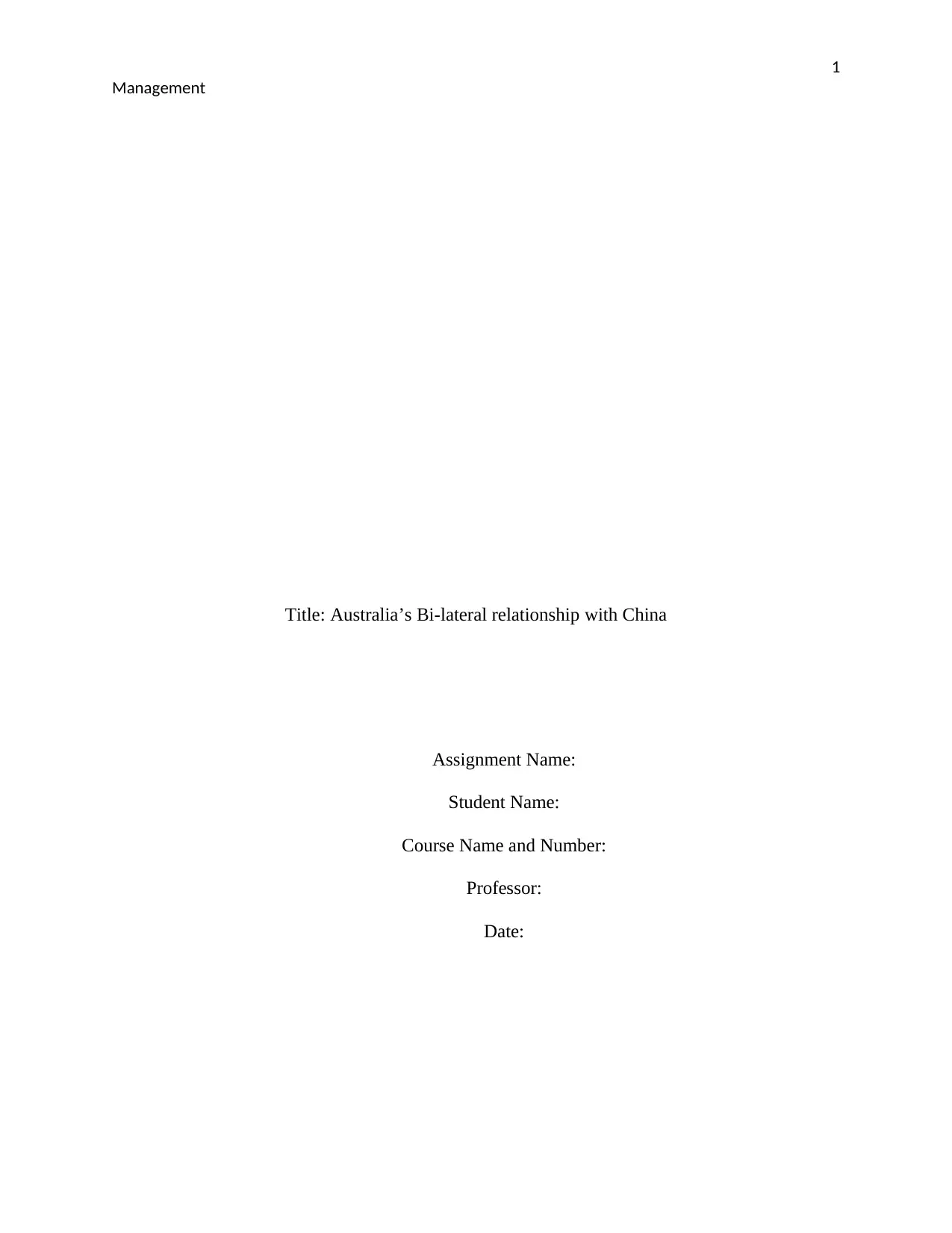
1
Management
Title: Australia’s Bi-lateral relationship with China
Assignment Name:
Student Name:
Course Name and Number:
Professor:
Date:
Management
Title: Australia’s Bi-lateral relationship with China
Assignment Name:
Student Name:
Course Name and Number:
Professor:
Date:
Paraphrase This Document
Need a fresh take? Get an instant paraphrase of this document with our AI Paraphraser
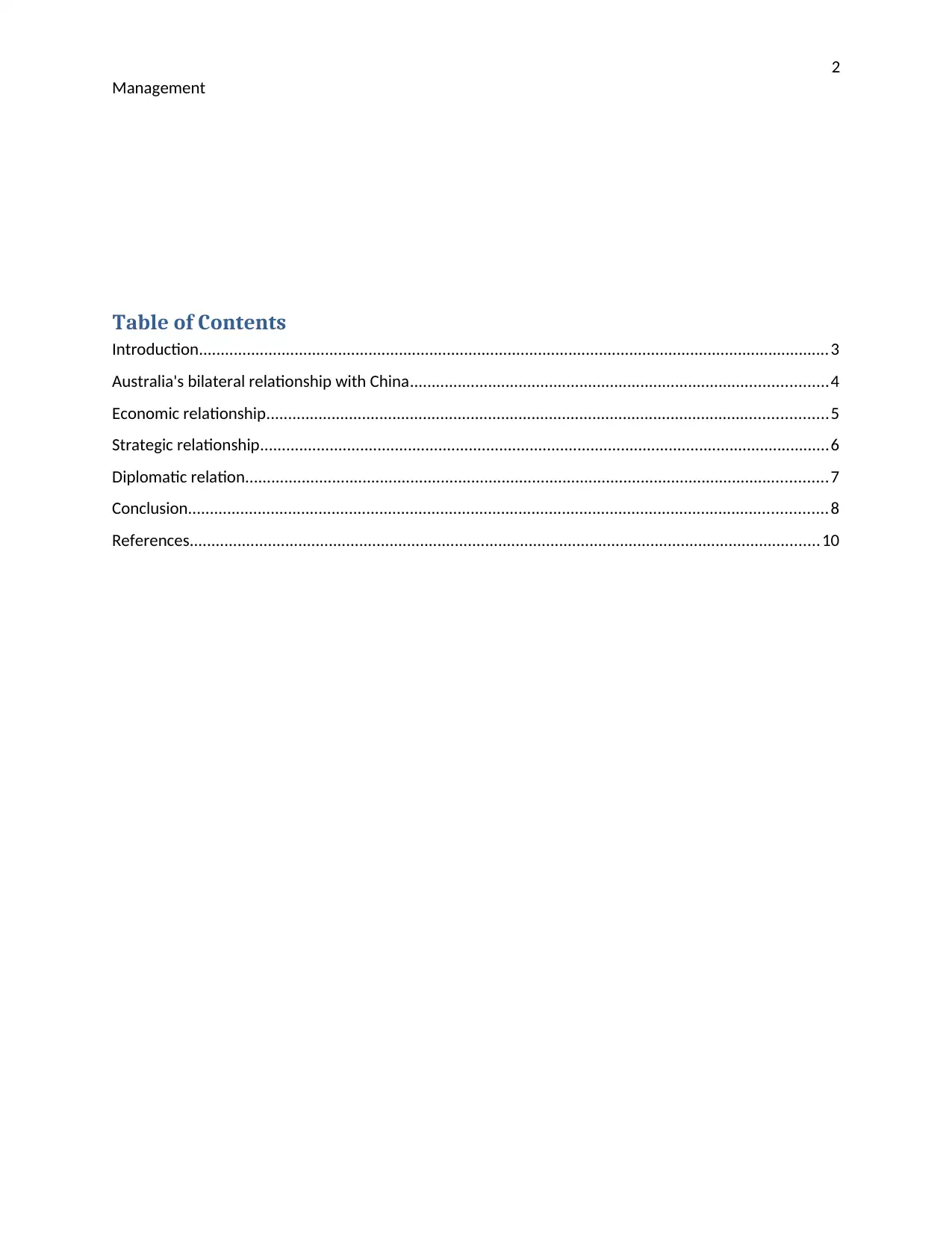
2
Management
Table of Contents
Introduction.................................................................................................................................................3
Australia's bilateral relationship with China................................................................................................4
Economic relationship.................................................................................................................................5
Strategic relationship...................................................................................................................................6
Diplomatic relation......................................................................................................................................7
Conclusion...................................................................................................................................................8
References.................................................................................................................................................10
Management
Table of Contents
Introduction.................................................................................................................................................3
Australia's bilateral relationship with China................................................................................................4
Economic relationship.................................................................................................................................5
Strategic relationship...................................................................................................................................6
Diplomatic relation......................................................................................................................................7
Conclusion...................................................................................................................................................8
References.................................................................................................................................................10

3
Management
Introduction
Australia’s foreign relations are highly influenced as a leading trade nation. Australia has
a profound bilateral relationship with its allies. In addition, it is also donates for the aumanitarian
aid. After the 1960s the trade has majorly been shifted to Asia as most of the top trading partners
with Australia is located there. China and Japan serve as the largest trading partners in Australia.
The rules and regulations in Australia are created in such a way that it provides stimulating
growth, therefore, making the economy more dynamic and flexible.
Australia has a significant role in many trade-related forums like G20, APEC, and WTO.
They constantly work to improve their bilateral, unilateral and multilateral trade liberalization.
Australia has a free trade agreement with countries like China and Japan. A large amount of
trade comes from these FTAs which add to 67 percent of total two-way trade. China is the largest
export market for Australia. Australian companies that are operating overseas caters as a major
Management
Introduction
Australia’s foreign relations are highly influenced as a leading trade nation. Australia has
a profound bilateral relationship with its allies. In addition, it is also donates for the aumanitarian
aid. After the 1960s the trade has majorly been shifted to Asia as most of the top trading partners
with Australia is located there. China and Japan serve as the largest trading partners in Australia.
The rules and regulations in Australia are created in such a way that it provides stimulating
growth, therefore, making the economy more dynamic and flexible.
Australia has a significant role in many trade-related forums like G20, APEC, and WTO.
They constantly work to improve their bilateral, unilateral and multilateral trade liberalization.
Australia has a free trade agreement with countries like China and Japan. A large amount of
trade comes from these FTAs which add to 67 percent of total two-way trade. China is the largest
export market for Australia. Australian companies that are operating overseas caters as a major
⊘ This is a preview!⊘
Do you want full access?
Subscribe today to unlock all pages.

Trusted by 1+ million students worldwide

4
Management
contribution to the Australian economy. A large section of trade is done with Iron ore making
Australia a leader in the global mining industry. A major section of the trade, includes Coal,
Natural gas and Uranium. The people’s republic of China agreed and accepted diplomatic
relation with Australia in the year of 1972. Since then Australia has established a number of
embassies across China. Both countries have a system of frequent visits accompanies with
cooperation of highest level. The recent change in climate has also been a reason for the bilateral
climate change partnership in 2004.
Australia's bilateral relationship with China
The relationship between Australia and China was farmed as “Comprehensive strategic
partnership”. There have strong economic and trade complementarities strengthing there
bilateral relationship which are quite extensive in nature. Australia has a number of Austrade
offices across Greater China and is present in China’s leading commercial centers. The annual
meeting held between the prime minister of Australia and Chinese premier covers discussion
over overseas and strategic relation, provincial and universal issues, human rights and
development of cooperation (Affairs, 2012).
The diplomatic relation between the two countries was established in 1941. Since the
relation serves for the development of both the sides and actively engage in cultural, political and
Management
contribution to the Australian economy. A large section of trade is done with Iron ore making
Australia a leader in the global mining industry. A major section of the trade, includes Coal,
Natural gas and Uranium. The people’s republic of China agreed and accepted diplomatic
relation with Australia in the year of 1972. Since then Australia has established a number of
embassies across China. Both countries have a system of frequent visits accompanies with
cooperation of highest level. The recent change in climate has also been a reason for the bilateral
climate change partnership in 2004.
Australia's bilateral relationship with China
The relationship between Australia and China was farmed as “Comprehensive strategic
partnership”. There have strong economic and trade complementarities strengthing there
bilateral relationship which are quite extensive in nature. Australia has a number of Austrade
offices across Greater China and is present in China’s leading commercial centers. The annual
meeting held between the prime minister of Australia and Chinese premier covers discussion
over overseas and strategic relation, provincial and universal issues, human rights and
development of cooperation (Affairs, 2012).
The diplomatic relation between the two countries was established in 1941. Since the
relation serves for the development of both the sides and actively engage in cultural, political and
Paraphrase This Document
Need a fresh take? Get an instant paraphrase of this document with our AI Paraphraser
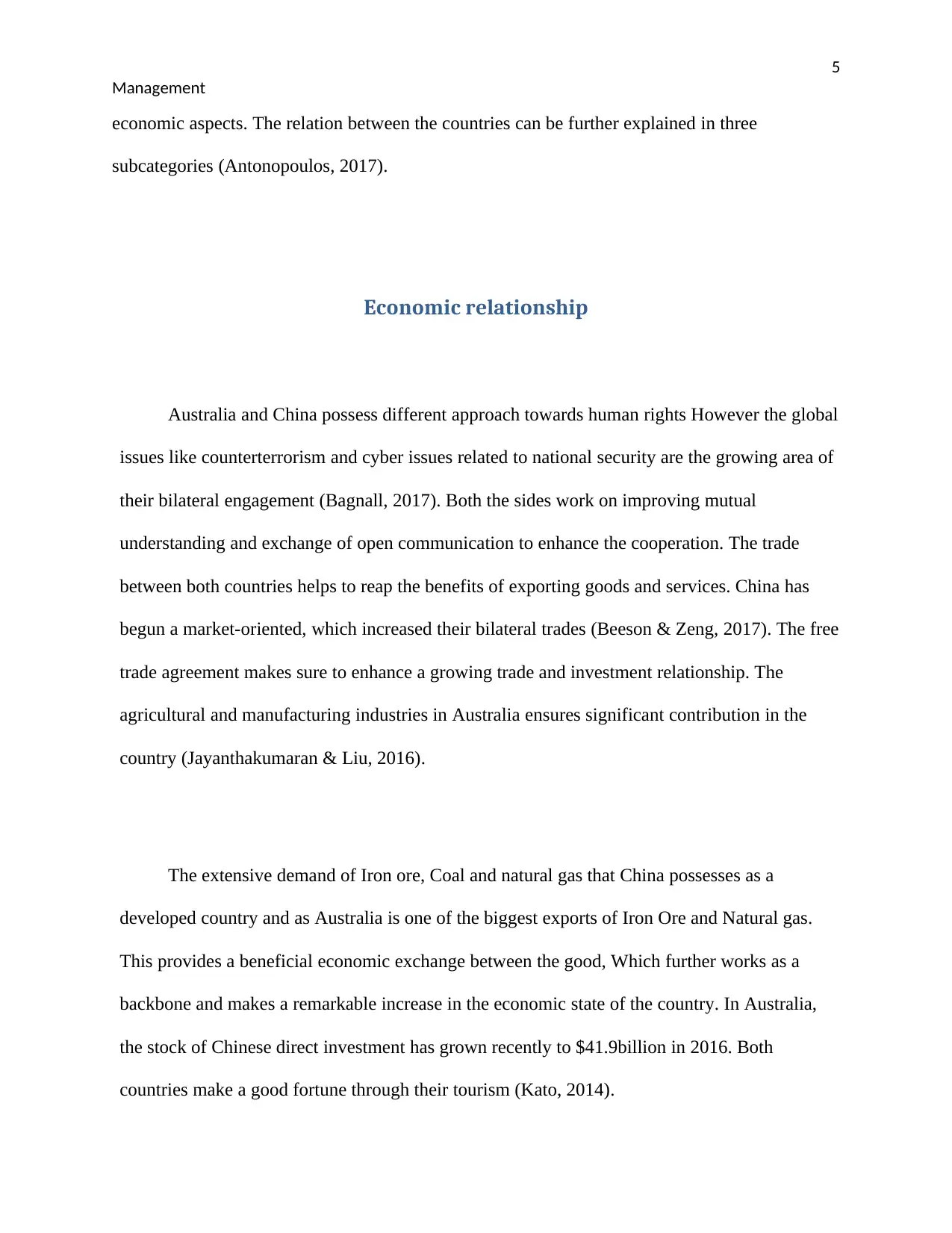
5
Management
economic aspects. The relation between the countries can be further explained in three
subcategories (Antonopoulos, 2017).
Economic relationship
Australia and China possess different approach towards human rights However the global
issues like counterterrorism and cyber issues related to national security are the growing area of
their bilateral engagement (Bagnall, 2017). Both the sides work on improving mutual
understanding and exchange of open communication to enhance the cooperation. The trade
between both countries helps to reap the benefits of exporting goods and services. China has
begun a market-oriented, which increased their bilateral trades (Beeson & Zeng, 2017). The free
trade agreement makes sure to enhance a growing trade and investment relationship. The
agricultural and manufacturing industries in Australia ensures significant contribution in the
country (Jayanthakumaran & Liu, 2016).
The extensive demand of Iron ore, Coal and natural gas that China possesses as a
developed country and as Australia is one of the biggest exports of Iron Ore and Natural gas.
This provides a beneficial economic exchange between the good, Which further works as a
backbone and makes a remarkable increase in the economic state of the country. In Australia,
the stock of Chinese direct investment has grown recently to $41.9billion in 2016. Both
countries make a good fortune through their tourism (Kato, 2014).
Management
economic aspects. The relation between the countries can be further explained in three
subcategories (Antonopoulos, 2017).
Economic relationship
Australia and China possess different approach towards human rights However the global
issues like counterterrorism and cyber issues related to national security are the growing area of
their bilateral engagement (Bagnall, 2017). Both the sides work on improving mutual
understanding and exchange of open communication to enhance the cooperation. The trade
between both countries helps to reap the benefits of exporting goods and services. China has
begun a market-oriented, which increased their bilateral trades (Beeson & Zeng, 2017). The free
trade agreement makes sure to enhance a growing trade and investment relationship. The
agricultural and manufacturing industries in Australia ensures significant contribution in the
country (Jayanthakumaran & Liu, 2016).
The extensive demand of Iron ore, Coal and natural gas that China possesses as a
developed country and as Australia is one of the biggest exports of Iron Ore and Natural gas.
This provides a beneficial economic exchange between the good, Which further works as a
backbone and makes a remarkable increase in the economic state of the country. In Australia,
the stock of Chinese direct investment has grown recently to $41.9billion in 2016. Both
countries make a good fortune through their tourism (Kato, 2014).
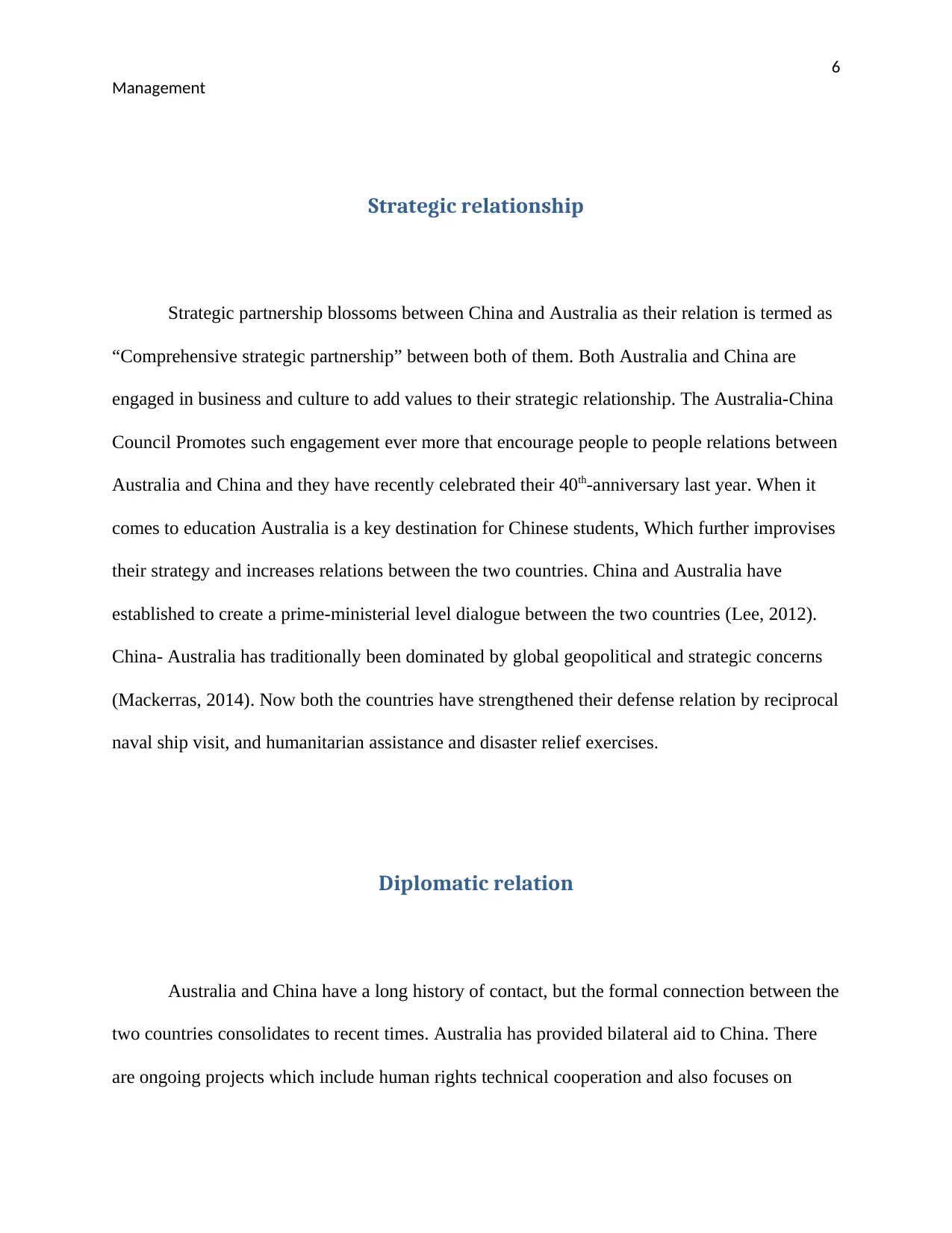
6
Management
Strategic relationship
Strategic partnership blossoms between China and Australia as their relation is termed as
“Comprehensive strategic partnership” between both of them. Both Australia and China are
engaged in business and culture to add values to their strategic relationship. The Australia-China
Council Promotes such engagement ever more that encourage people to people relations between
Australia and China and they have recently celebrated their 40th-anniversary last year. When it
comes to education Australia is a key destination for Chinese students, Which further improvises
their strategy and increases relations between the two countries. China and Australia have
established to create a prime-ministerial level dialogue between the two countries (Lee, 2012).
China- Australia has traditionally been dominated by global geopolitical and strategic concerns
(Mackerras, 2014). Now both the countries have strengthened their defense relation by reciprocal
naval ship visit, and humanitarian assistance and disaster relief exercises.
Diplomatic relation
Australia and China have a long history of contact, but the formal connection between the
two countries consolidates to recent times. Australia has provided bilateral aid to China. There
are ongoing projects which include human rights technical cooperation and also focuses on
Management
Strategic relationship
Strategic partnership blossoms between China and Australia as their relation is termed as
“Comprehensive strategic partnership” between both of them. Both Australia and China are
engaged in business and culture to add values to their strategic relationship. The Australia-China
Council Promotes such engagement ever more that encourage people to people relations between
Australia and China and they have recently celebrated their 40th-anniversary last year. When it
comes to education Australia is a key destination for Chinese students, Which further improvises
their strategy and increases relations between the two countries. China and Australia have
established to create a prime-ministerial level dialogue between the two countries (Lee, 2012).
China- Australia has traditionally been dominated by global geopolitical and strategic concerns
(Mackerras, 2014). Now both the countries have strengthened their defense relation by reciprocal
naval ship visit, and humanitarian assistance and disaster relief exercises.
Diplomatic relation
Australia and China have a long history of contact, but the formal connection between the
two countries consolidates to recent times. Australia has provided bilateral aid to China. There
are ongoing projects which include human rights technical cooperation and also focuses on
⊘ This is a preview!⊘
Do you want full access?
Subscribe today to unlock all pages.

Trusted by 1+ million students worldwide
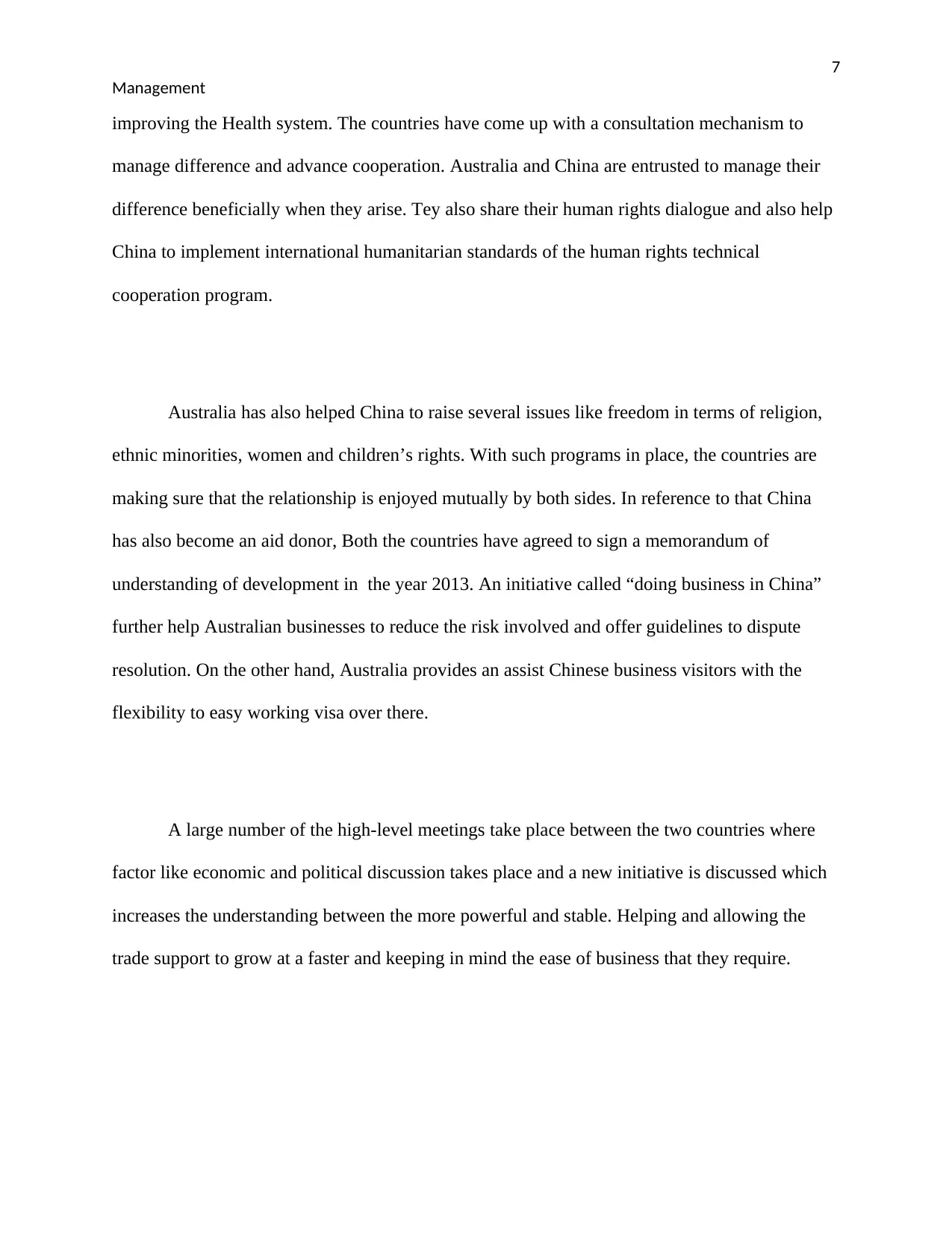
7
Management
improving the Health system. The countries have come up with a consultation mechanism to
manage difference and advance cooperation. Australia and China are entrusted to manage their
difference beneficially when they arise. Tey also share their human rights dialogue and also help
China to implement international humanitarian standards of the human rights technical
cooperation program.
Australia has also helped China to raise several issues like freedom in terms of religion,
ethnic minorities, women and children’s rights. With such programs in place, the countries are
making sure that the relationship is enjoyed mutually by both sides. In reference to that China
has also become an aid donor, Both the countries have agreed to sign a memorandum of
understanding of development in the year 2013. An initiative called “doing business in China”
further help Australian businesses to reduce the risk involved and offer guidelines to dispute
resolution. On the other hand, Australia provides an assist Chinese business visitors with the
flexibility to easy working visa over there.
A large number of the high-level meetings take place between the two countries where
factor like economic and political discussion takes place and a new initiative is discussed which
increases the understanding between the more powerful and stable. Helping and allowing the
trade support to grow at a faster and keeping in mind the ease of business that they require.
Management
improving the Health system. The countries have come up with a consultation mechanism to
manage difference and advance cooperation. Australia and China are entrusted to manage their
difference beneficially when they arise. Tey also share their human rights dialogue and also help
China to implement international humanitarian standards of the human rights technical
cooperation program.
Australia has also helped China to raise several issues like freedom in terms of religion,
ethnic minorities, women and children’s rights. With such programs in place, the countries are
making sure that the relationship is enjoyed mutually by both sides. In reference to that China
has also become an aid donor, Both the countries have agreed to sign a memorandum of
understanding of development in the year 2013. An initiative called “doing business in China”
further help Australian businesses to reduce the risk involved and offer guidelines to dispute
resolution. On the other hand, Australia provides an assist Chinese business visitors with the
flexibility to easy working visa over there.
A large number of the high-level meetings take place between the two countries where
factor like economic and political discussion takes place and a new initiative is discussed which
increases the understanding between the more powerful and stable. Helping and allowing the
trade support to grow at a faster and keeping in mind the ease of business that they require.
Paraphrase This Document
Need a fresh take? Get an instant paraphrase of this document with our AI Paraphraser
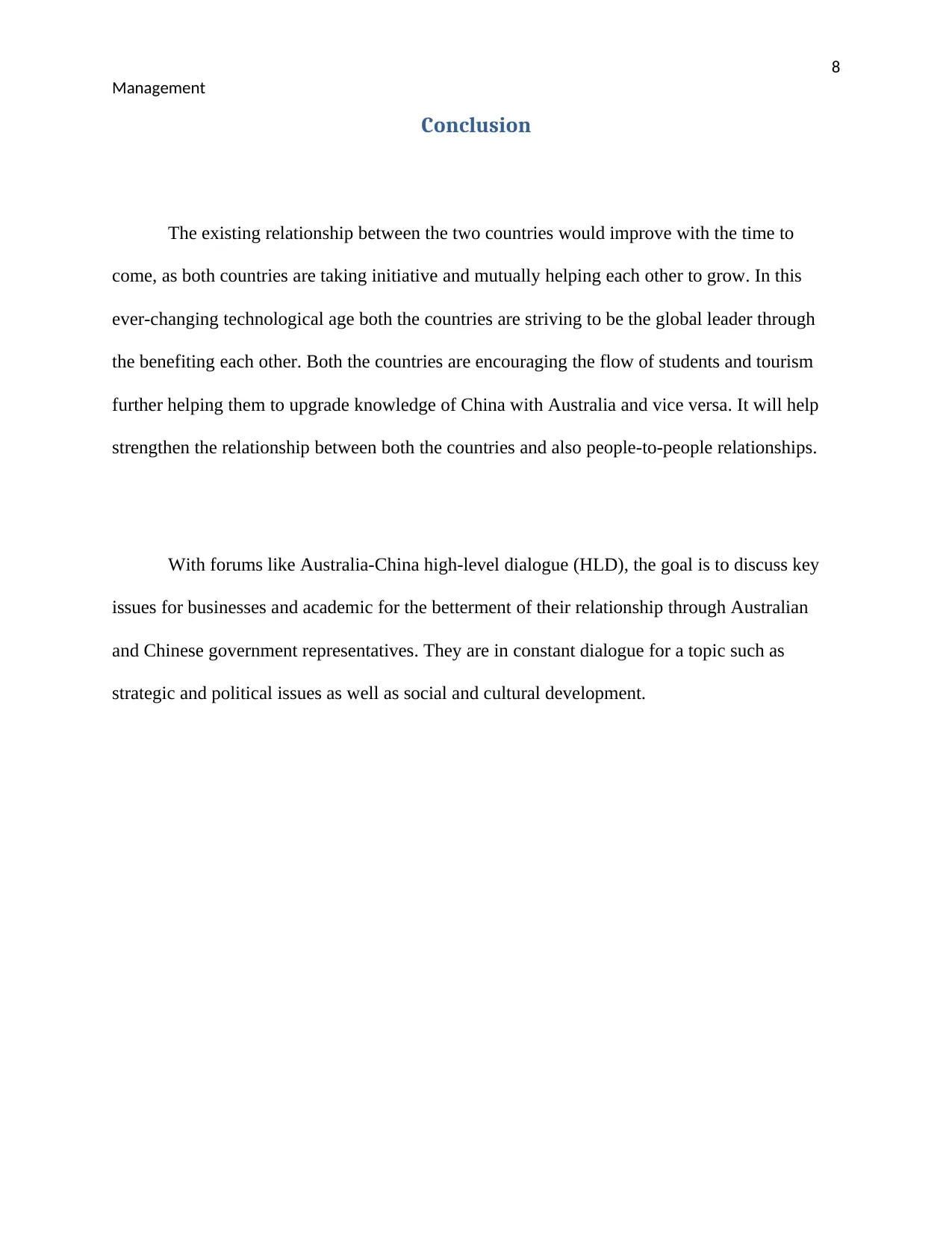
8
Management
Conclusion
The existing relationship between the two countries would improve with the time to
come, as both countries are taking initiative and mutually helping each other to grow. In this
ever-changing technological age both the countries are striving to be the global leader through
the benefiting each other. Both the countries are encouraging the flow of students and tourism
further helping them to upgrade knowledge of China with Australia and vice versa. It will help
strengthen the relationship between both the countries and also people-to-people relationships.
With forums like Australia-China high-level dialogue (HLD), the goal is to discuss key
issues for businesses and academic for the betterment of their relationship through Australian
and Chinese government representatives. They are in constant dialogue for a topic such as
strategic and political issues as well as social and cultural development.
Management
Conclusion
The existing relationship between the two countries would improve with the time to
come, as both countries are taking initiative and mutually helping each other to grow. In this
ever-changing technological age both the countries are striving to be the global leader through
the benefiting each other. Both the countries are encouraging the flow of students and tourism
further helping them to upgrade knowledge of China with Australia and vice versa. It will help
strengthen the relationship between both the countries and also people-to-people relationships.
With forums like Australia-China high-level dialogue (HLD), the goal is to discuss key
issues for businesses and academic for the betterment of their relationship through Australian
and Chinese government representatives. They are in constant dialogue for a topic such as
strategic and political issues as well as social and cultural development.

9
Management
References
Affairs, D. (2012). DFA - Department of Foreign Affairs and Trade. Retrieved from
http://www.dfa.ie/
Antonopoulos, P. (2017). The Kangaroo, the Bear, and the Dragon: Australia-Russia-China
Relations in the “Asian Century”. China Quarterly Of International Strategic
Studies, 03(03), 411-428.
Bagnall, K. (2017). A new perspective on Australia and China. History Australia, 14(4), 666-667.
Beeson, M., & Zeng, J. (2017). Realistic Relations? How the Evolving Bilateral Relationship is
Understood in China and Australia. Pacific Focus, 32(2), 159-181.
Jayanthakumaran, K., & Liu, Y. (2016). Bi-lateral CO 2 emissions embodied in Australia–China
trade. Energy Policy, 92, 205-213.
Kato, T. (2014). Relationship between Coping with Interpersonal Stressors and Depressive
Symptoms in the United States, Australia, and China: A Focus on Reassessing Coping. Plos
ONE, 9(10), e109644.
Management
References
Affairs, D. (2012). DFA - Department of Foreign Affairs and Trade. Retrieved from
http://www.dfa.ie/
Antonopoulos, P. (2017). The Kangaroo, the Bear, and the Dragon: Australia-Russia-China
Relations in the “Asian Century”. China Quarterly Of International Strategic
Studies, 03(03), 411-428.
Bagnall, K. (2017). A new perspective on Australia and China. History Australia, 14(4), 666-667.
Beeson, M., & Zeng, J. (2017). Realistic Relations? How the Evolving Bilateral Relationship is
Understood in China and Australia. Pacific Focus, 32(2), 159-181.
Jayanthakumaran, K., & Liu, Y. (2016). Bi-lateral CO 2 emissions embodied in Australia–China
trade. Energy Policy, 92, 205-213.
Kato, T. (2014). Relationship between Coping with Interpersonal Stressors and Depressive
Symptoms in the United States, Australia, and China: A Focus on Reassessing Coping. Plos
ONE, 9(10), e109644.
⊘ This is a preview!⊘
Do you want full access?
Subscribe today to unlock all pages.

Trusted by 1+ million students worldwide
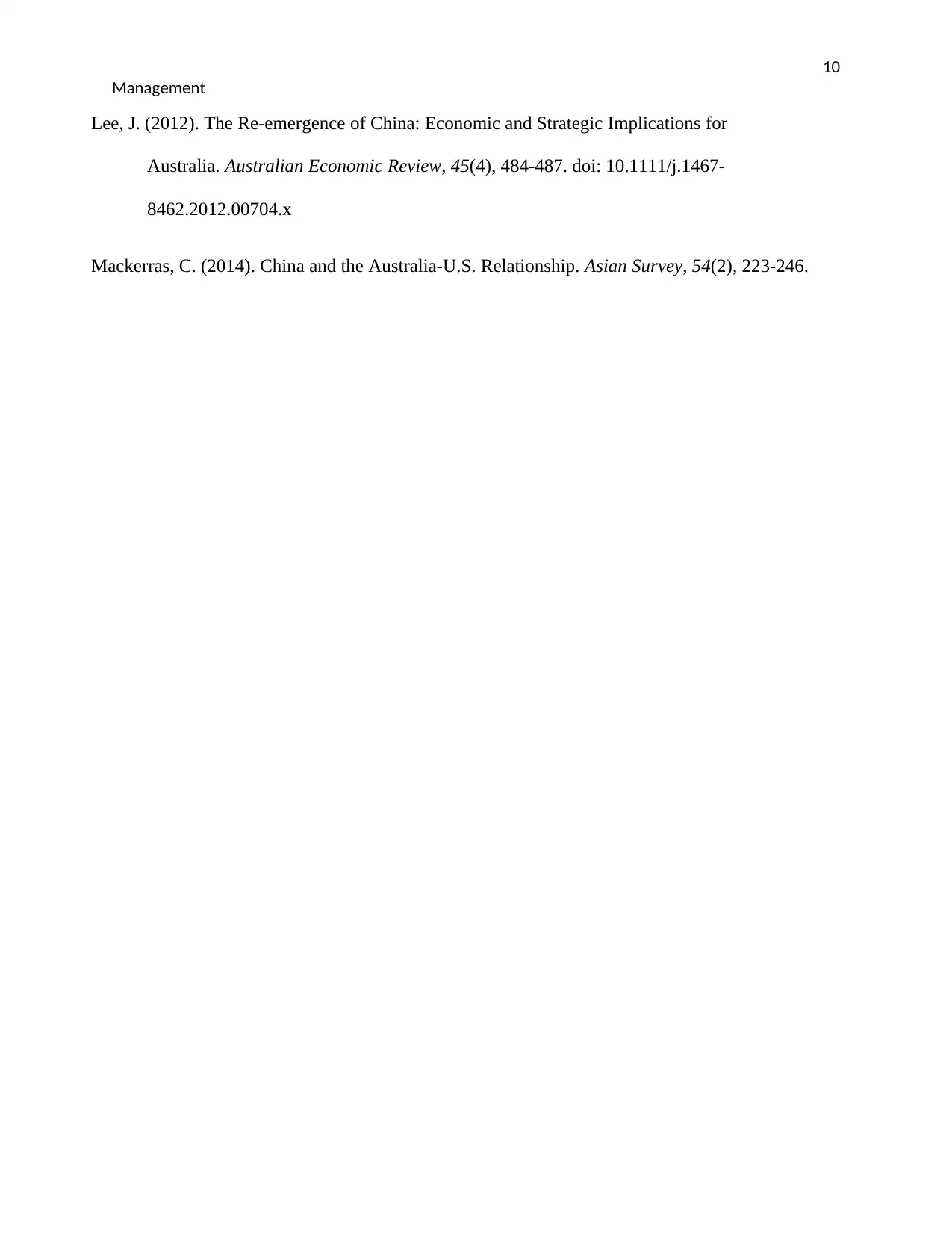
10
Management
Lee, J. (2012). The Re-emergence of China: Economic and Strategic Implications for
Australia. Australian Economic Review, 45(4), 484-487. doi: 10.1111/j.1467-
8462.2012.00704.x
Mackerras, C. (2014). China and the Australia-U.S. Relationship. Asian Survey, 54(2), 223-246.
Management
Lee, J. (2012). The Re-emergence of China: Economic and Strategic Implications for
Australia. Australian Economic Review, 45(4), 484-487. doi: 10.1111/j.1467-
8462.2012.00704.x
Mackerras, C. (2014). China and the Australia-U.S. Relationship. Asian Survey, 54(2), 223-246.
1 out of 10
Related Documents
Your All-in-One AI-Powered Toolkit for Academic Success.
+13062052269
info@desklib.com
Available 24*7 on WhatsApp / Email
![[object Object]](/_next/static/media/star-bottom.7253800d.svg)
Unlock your academic potential
Copyright © 2020–2025 A2Z Services. All Rights Reserved. Developed and managed by ZUCOL.




